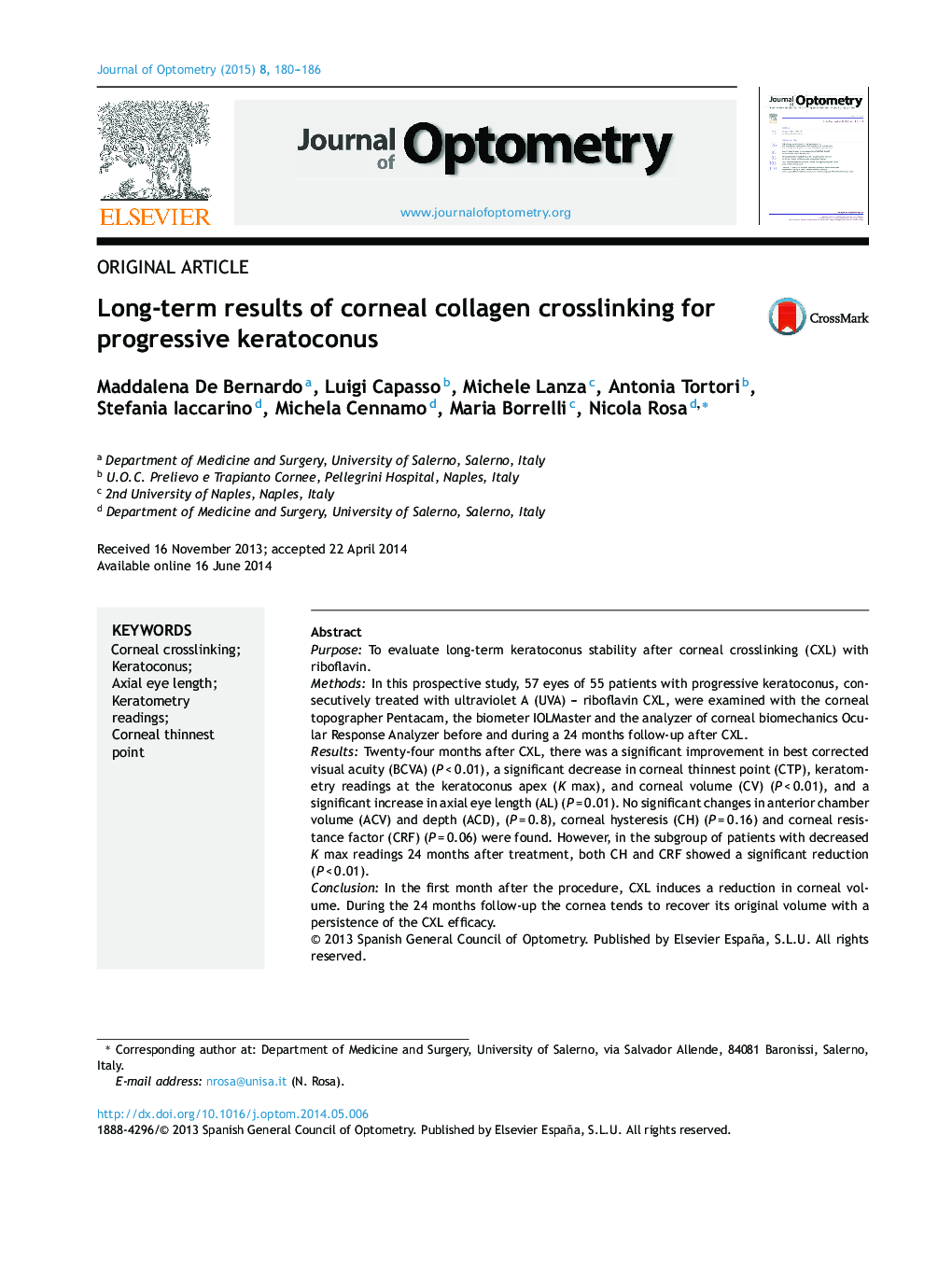| کد مقاله | کد نشریه | سال انتشار | مقاله انگلیسی | نسخه تمام متن |
|---|---|---|---|---|
| 2694967 | 1143710 | 2015 | 7 صفحه PDF | دانلود رایگان |
PurposeTo evaluate long-term keratoconus stability after corneal crosslinking (CXL) with riboflavin.MethodsIn this prospective study, 57 eyes of 55 patients with progressive keratoconus, consecutively treated with ultraviolet A (UVA) – riboflavin CXL, were examined with the corneal topographer Pentacam, the biometer IOLMaster and the analyzer of corneal biomechanics Ocular Response Analyzer before and during a 24 months follow-up after CXL.ResultsTwenty-four months after CXL, there was a significant improvement in best corrected visual acuity (BCVA) (P < 0.01), a significant decrease in corneal thinnest point (CTP), keratometry readings at the keratoconus apex (K max), and corneal volume (CV) (P < 0.01), and a significant increase in axial eye length (AL) (P = 0.01). No significant changes in anterior chamber volume (ACV) and depth (ACD), (P = 0.8), corneal hysteresis (CH) (P = 0.16) and corneal resistance factor (CRF) (P = 0.06) were found. However, in the subgroup of patients with decreased K max readings 24 months after treatment, both CH and CRF showed a significant reduction (P < 0.01).ConclusionIn the first month after the procedure, CXL induces a reduction in corneal volume. During the 24 months follow-up the cornea tends to recover its original volume with a persistence of the CXL efficacy.
ResumenObjetivoEvaluar la estabilidad del queratocono a largo plazo tras cross-linking corneal (CXL) con riboflavina.MétodosEn este estudio prospectivo, se examinaron 57 ojos de 55 pacientes con queratocono progresivo, tratados consecutivamente con UVA-CXL con riboflavina utilizando el topógrafo corneal Pentacam, el biómetro IOLMaster y el analizar de la biomecánica corneal “Ocular Response Analyzer” preoperatoriamente y a los 24 meses de haberse realizado el CXL.ResultadosA los veinticuatro meses del CXL, se produjo una mejora considerable de la agudeza visual mejor corregida (BCVA) (p < 0.01), un importante decremento del punto más fino de la córnea (CTP), de las medidas queratométricas en el vértice del queratocono (K max), y del volumen de la córnea (VC) (p < 0.01), y un incremento significativo de la longitud axial del ojo (LA) (p = 0.01). No se produjeron cambios significativos en el volumen de la cámara anterior (VCA) ni en la profundidad de la misma (PCA), (p = 0.8), histéresis de la córnea (HC) (p = 0.16) y factor de resistencia de la córnea (FRC) (p = 0.06). Sin embargo, en el subgrupo de pacientes con disminución de los valores de K max, a los 24 meses del tratamiento, tanto la HC como la FRC mostraron una reducción considerable (p < 0.01).ConclusiónDurante el primer mes tras la intervención, el CXL induce una reducción del volumen de la córnea. Durante los 24 meses de seguimiento, la córnea tiende a recuperar su volumen original, persistiendo la eficacia del CXL.
Journal: Journal of Optometry - Volume 8, Issue 3, July–September 2015, Pages 180–186
